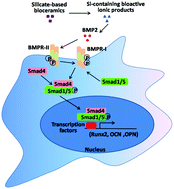当前位置:
X-MOL 学术
›
J. Mater. Chem. B
›
论文详情
Our official English website, www.x-mol.net, welcomes your
feedback! (Note: you will need to create a separate account there.)
Silicate-based bioceramics regulating osteoblast differentiation through a BMP2 signalling pathway
Journal of Materials Chemistry B ( IF 6.1 ) Pub Date : 2017-08-09 00:00:00 , DOI: 10.1039/c7tb01931a Dong Zhai 1, 2, 3, 4, 5 , Mengchi Xu 1, 2, 3, 4, 5 , Liqi Liu 1, 2, 3, 4, 5 , Jiang Chang 1, 2, 3, 4, 5 , Chengtie Wu 1, 2, 3, 4, 5
Journal of Materials Chemistry B ( IF 6.1 ) Pub Date : 2017-08-09 00:00:00 , DOI: 10.1039/c7tb01931a Dong Zhai 1, 2, 3, 4, 5 , Mengchi Xu 1, 2, 3, 4, 5 , Liqi Liu 1, 2, 3, 4, 5 , Jiang Chang 1, 2, 3, 4, 5 , Chengtie Wu 1, 2, 3, 4, 5
Affiliation

|
Bioactive materials with osteostimulation properties have the potential to promote bone regeneration. We have found that silicate-based biomaterials have the osteostimulation ability for regeneration of large bone defects; however, the corresponding mechanism is unclear. In this study, we set out to elucidate the potential mechanism of silicate-based biomaterials with osteostimulation ability. A model silicate bioceramic, nagelschmidtite (NAGEL, Ca7P2Si2O16), was applied to study their ionic products on the effect of the Bone morphogenic protein (BMP) signaling pathway for osteoblast MC3T3-E1 as NAGEL has been previously shown to have excellent in vitro and in vivo bone-forming activity. BMP signaling, especially BMP2, is involved in bone formation during mammalian development and exhibits versatile regulatory functions in the body. It is found that NAGEL bioceramics significantly enhance the migration and osteoblastic differentiation of MC3T3-E1. mRNA and protein expression of BMP2 is enhanced by NAGEL bioceramics in a dose-dependent manner. Moreover, NAGEL bioceramics activate the Smad-dependent BMP signaling pathway and induce the activation of the BMP downstream cascade (OCN, OPN and Runx2). The accumulation of phosphorylated-Smad1/5 is induced by NAGEL bioceramics in the MC3T3-E1 cell nucleus. It is further found that NAGEL bioceramic-mediated migration, osteoblastic differentiation and the activation of the BMP downstream cascade are significantly downregulated by inhibition of BMP2 activity. Our results suggest that silicate-based NAGEL bioceramics possess excellent in vitro osteostimulation properties and the possible mechanism of silicate-based biomaterials with distinct osteostimulation may be directly related to the activation of the BMP2 signaling pathway of osteoblasts by release of Si-containing bioactive ionic products.
中文翻译:

基于硅酸盐的生物陶瓷通过BMP2信号通路调节成骨细胞的分化
具有骨刺激特性的生物活性材料具有促进骨再生的潜力。我们发现硅酸盐基生物材料具有刺激大骨缺损再生的骨刺激能力。但是,相应的机制尚不清楚。在这项研究中,我们着手阐明具有骨刺激能力的硅酸盐基生物材料的潜在机制。如先前所示,使用模型硅酸盐生物陶瓷nagelschmidtite(NAGEL,Ca 7 P 2 Si 2 O 16)研究其离子产物对成骨细胞MC3T3-E1的骨形态发生蛋白(BMP)信号传导途径的影响。具有出色的体外和体内骨形成活动。BMP信号,尤其是BMP2,在哺乳动物发育过程中参与骨骼形成,并在体内表现出多种调节功能。发现NAGEL生物陶瓷显着增强了MC3T3-E1的迁移和成骨细胞分化。NAGEL生物陶瓷以剂量依赖的方式增强BMP2的mRNA和蛋白质表达。此外,NAGEL生物陶瓷激活Smad依赖性BMP信号传导途径,并诱导BMP下游级联反应(OCN,OPN和Runx2)的激活。NAGEL生物陶瓷在MC3T3-E1细胞核中诱导磷酸化Smad1 / 5的积累。进一步发现,通过抑制BMP2活性,NAGEL生物陶瓷介导的迁移,成骨细胞分化和BMP下游级联反应的激活被显着下调。体外骨刺激特性和具有独特骨刺激作用的硅酸盐基生物材料的可能机制可能与成骨细胞BMP2信号通路通过释放含硅生物活性离子产物的活化有关。
更新日期:2017-09-13
中文翻译:

基于硅酸盐的生物陶瓷通过BMP2信号通路调节成骨细胞的分化
具有骨刺激特性的生物活性材料具有促进骨再生的潜力。我们发现硅酸盐基生物材料具有刺激大骨缺损再生的骨刺激能力。但是,相应的机制尚不清楚。在这项研究中,我们着手阐明具有骨刺激能力的硅酸盐基生物材料的潜在机制。如先前所示,使用模型硅酸盐生物陶瓷nagelschmidtite(NAGEL,Ca 7 P 2 Si 2 O 16)研究其离子产物对成骨细胞MC3T3-E1的骨形态发生蛋白(BMP)信号传导途径的影响。具有出色的体外和体内骨形成活动。BMP信号,尤其是BMP2,在哺乳动物发育过程中参与骨骼形成,并在体内表现出多种调节功能。发现NAGEL生物陶瓷显着增强了MC3T3-E1的迁移和成骨细胞分化。NAGEL生物陶瓷以剂量依赖的方式增强BMP2的mRNA和蛋白质表达。此外,NAGEL生物陶瓷激活Smad依赖性BMP信号传导途径,并诱导BMP下游级联反应(OCN,OPN和Runx2)的激活。NAGEL生物陶瓷在MC3T3-E1细胞核中诱导磷酸化Smad1 / 5的积累。进一步发现,通过抑制BMP2活性,NAGEL生物陶瓷介导的迁移,成骨细胞分化和BMP下游级联反应的激活被显着下调。体外骨刺激特性和具有独特骨刺激作用的硅酸盐基生物材料的可能机制可能与成骨细胞BMP2信号通路通过释放含硅生物活性离子产物的活化有关。











































 京公网安备 11010802027423号
京公网安备 11010802027423号